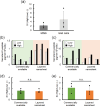Multilayered Freestanding Porous Polycarbonate Nanosheets with Directed Protein Permeability for Cell-Encapsulated Devices
- PMID: 39951110
- PMCID: PMC11921017
- DOI: 10.1021/acsabm.4c01446
Multilayered Freestanding Porous Polycarbonate Nanosheets with Directed Protein Permeability for Cell-Encapsulated Devices
Abstract
Implantable pancreatic β cell-encapsulated devices are required for the treatment of type 1 diabetes. Such devices should enable a semipermeable membrane to release insulin in response to glucose levels while avoiding immune reactions. Micrometer-thick track-etched porous polycarbonate (PC) membranes have been used for this purpose. However, the immediate release of insulin remains a challenge in the development of such semipermeable membranes. Herein, we attempted to develop a freestanding polymeric ultrathin film (nanosheet) with a porous structure that can be used in a cell-encapsulated device. Specifically, we fabricated a nonbiodegradable, porous PC nanosheet to enhance molecular permeability. The nanosheet was multistacked to ensure the controlled permeability of proteins of various molecular weights, such as insulin and IgG. The porous PC nanosheet was prepared by gravure coating using a blend solution comprising PC and polystyrene (PS) to induce macro-phase separation of the PC and PS. When the PC:PS weight ratio of the mixture was reduced to 3:1, we succeeded in fabricating a porous PC nanosheet (thickness: 100 nm, diameter: < 2.5 μm). A triple layer of such porous nanosheets with various pore sizes demonstrated 10 times less protein clogging, 10 times higher insulin permeability, and comparable IgG-blocking capability compared with commercially available porous PC membranes (thickness: 10 μm). Finally, we demonstrated that a cell-encapsulated device equipped with the multilayered porous PC nanosheet as a permeable membrane preserved the glucose response level of insulin-producing cells before, during, and after the cell-encapsulation process. We believe that cell-encapsulated devices equipped with such porous PC nanosheets will enable immediate insulin release in response to changes in glucose levels.
Keywords: cell-encapsulated device; insulin; phase separation; polycarbonate; polymeric ultra-thin film (nanosheet).
Conflict of interest statement
The authors declare no competing financial interest.
Figures





Similar articles
-
Self-folding immunoprotective cell encapsulation devices.Nanomedicine. 2011 Dec;7(6):686-9. doi: 10.1016/j.nano.2011.08.020. Epub 2011 Sep 21. Nanomedicine. 2011. PMID: 21945897
-
Nanoporous alumina capsules for cellular macroencapsulation: transport and biocompatibility.Diabetes Technol Ther. 2005 Oct;7(5):684-94. doi: 10.1089/dia.2005.7.684. Diabetes Technol Ther. 2005. PMID: 16241869
-
In situ transplantation of adipose tissue-derived stem cells organized on porous polymer nanosheets for murine skin defects.J Biomed Mater Res B Appl Biomater. 2019 Jul;107(5):1363-1371. doi: 10.1002/jbm.b.34228. Epub 2018 Sep 28. J Biomed Mater Res B Appl Biomater. 2019. PMID: 30265776
-
Highly Permeable MoS2 Nanosheet Porous Membrane for Organic Matter Removal.ACS Omega. 2022 Jan 6;7(2):2419-2428. doi: 10.1021/acsomega.1c06480. eCollection 2022 Jan 18. ACS Omega. 2022. PMID: 35071929 Free PMC article.
-
Nano-porous anodic alumina: fundamentals and applications in tissue engineering.J Mater Sci Mater Med. 2020 Jul 8;31(7):60. doi: 10.1007/s10856-020-06398-2. J Mater Sci Mater Med. 2020. PMID: 32642974 Review.
References
-
- El Malahi A.; Van Elsen M.; Charleer S.; Dirinck E.; Ledeganck K.; Keymeulen B.; Crenier L.; Radermecker Rc. D. S.; Taes Y.; Vercammen C.; Nobels F.; Mathieu C.; Gillard P.; De Block C. Relationship between Time in Range, Glycemic Variability, HbA1c, and Complications in Adults with Type 1 Diabetes Mellitus. J. Clin Endocrinol Metab 2022, 107 (2), e570–e581. 10.1210/clinem/dgab688. - DOI - PubMed
MeSH terms
Substances
LinkOut - more resources
Full Text Sources
Medical
